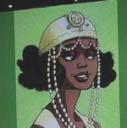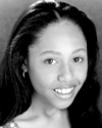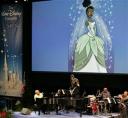One of my favorite ‘stereotypes in media’ moments is when I get to use my own background to instill critical thinking skills in teens.
At the national Girls For A Change summitfor instance, I had the opportunity to break through race barriers and color codes of perceived expectations by starting off the session asking teens, “Okay, so who was I in high school?” to get the media stereotypes flying…As the girls started blurting out blonde-Barbie-isms and “Princess” banter, I added to the incredulousness by saying that I grew up as ‘a minority’ most of my life.
That’s when necks start to swivel and faces squinch up in that ‘you-gadda-be-kiddin -me-lady-get-real’ look…A few connected the dots quickly to lead the others through the process like a scavenger hunt, probing into ‘how that could be.’ (yup, formative years in Hawaii, D.C. and Japan, none of which were brimming with tall blonde-haole girls at the time)
Things are NOT always ‘as they appear’…which is why the whole ‘fairy princess’ marketing bit sticks in my craw as aspirational hooey…planting stereotypes over storylines, and gender/race-based ideals of what kids ‘should’ grow up to be.
In my house, I brushed off princesses dismissively rather than give them any ‘heat’ at all, preferring to subversively turn stereotypes upside down with a wink and a nod reading fairytales like The Paper Bag Princess (who does NOT live happily ever after with Ronald) and Dinorella (the dinosaur that saves ‘Duke Dudley’s tail, quite literally). Sure, we read the classics, but it became a favorite past-time to add a dollop of irony to the usual palate of kid-lit and lack of cultural diversity in the princess posse.
This report from the Howard Hughes Medical Institute, called “How Do We See Colors?” may focus on neurons and rod cells, but I can’t help but make that leap into the media/marketing sphere and see how it also applies to race, visual imagery and snap-sensory judgment setting what’s ‘normative’ in terms of kids optical intake.
As researcher Jeremy Nathans at the Johns Hopkins University School of Medicine describes, “If a bright red beach ball comes whirling toward you, you see its color, shape, and motion all at once—but your brain deals with each of these characteristics separately.”
So how might that apply to the way our brains take in visual cues and other sensory processors as it relates to children’s brandwashing of behavioral cues and learning environments…from ‘princesses’ to the toxic Beyoncé pornification of preschoolers in terms of what gets sifted, sorted and compartmentalized in kids’ environs. (If any of you science folks have links and studies on this, send ‘em my way!)
Michelle Malkin’s piece shows how the media mix of adding ‘diversity’ can cue a misguided ‘pop’ princess persona that borders on pedophilia… Bleh.
Meanwhile, Deesha Philyaw, a columnist for Anti-Racist Parent, (one of Shaping Youth advisory board member Carmen Van Kerckhove’s many excellent contributions to the blogosphere) has given us the go ahead to crosspost her fabulous piece on “The Princess Problem,” which is a must-read for anyone who remotely thinks there isn’t one.
Deesha Philyaw is also a freelance writer who has written for Essence Magazine, Wondertime Magazine (a Disney publication), and The Washington Post, with a B.A. in economics from Yale University and a Master’s degree in teaching…
Her own blog, Mamalicious is now boldly bookmarked in my Google Reader too.
Sometimes I think that once Shaping Youth launches our ‘real site’ my blogroll/resource page will need a server of its own!
It’s encouraging to see so many great minds out there trying to shake it up and make the world a healthier place in the media sphere for kids…Thanks, Deesha, for being one of them!
The Princess Problem:
“There’s more than one way of being pretty.” by Deesha Philyaw
As the mother of two girls who do not live under rocks, I have not been able to escape the whole princess thing. A few years back, when my oldest was in kindergarten and my youngest was an infant, I wrote a column (for another site) about how, as I kid, I had embraced media messages that promoted a “white is right” standard of beauty (show of hands: Who else wore the white towel on her head to become Farrah Fawcett’s character on Charlie’s Angels?). I didn’t want my own daughters to go down this path:
…I take a special interest in the media images my children consume, as do most parents I know, regardless of race. I don’t rely on entertainment executives or book authors to affirm or protect my children. That’s my job. But I do seek out age-appropriate books, movies, and other media that reflect the diversity of the world in which we live, with characters who look like us and the people we know and love.
But what about fairytales and the other “classics,” those all-white, generations-old stories and characters that are presumed staples of American cultural literacy, likely to turn up as “Jeopardy” questions? We love “The Sound of Music” and “Mary Poppins”, but quick: Name an American children’s classic featuring a black cast. The good, but depressing “Sounder”?
Should classic stories and movies be avoided then because they tend to feature all-white casts? In our family, we sometimes take a “don’t ask-don’t tell” approach. For example, we simply don’t do princesses. I never told my older daughter, T, about Sleeping Beauty and company, and she never asked about them.
Until this year. Nearly every girl in T’s kindergarten class is infatuated with princesses. I have an aversion to princesses. Actually, I have an aversion to pretty much anything that invites McDonalds or Burger King to stick a related action figure into a kid’s meal. But I find princesses especially grating. I don’t like the helplessness thing, the dependence on a man to feel complete…thing.
Thankfully, T isn’t anywhere near as obsessed with princesses as her peers. With the exception of the “Wonderful World of Disney’s” Cinderella [featuring singer Brandy in the lead role, and Whitney Houston as the fairy godmother], we’ve managed to avoid Disney’s offerings of the I-need-to-be-rescued princess tales…
You see, back then, I was able to write about the princess thing fairly calmly, fairly rationally. These days, when the princess-mafia has my youngest daughter’s preschool on lock? Not so much.
I am so over the whole princess thing. Over it.
I want Cinderella to develop hammertoes from jamming her anatomically-impossible feet into completely impractical glass slippers. I want Belle and her books to go to a library far, far away. I want Sleeping Beauty to keep hitting “snooze.” Here, Snow White…have an apple.
I never want to see anything pink again. Nothing. I want that sheer-iridescent-pink-nightmare of a fairy/princess/angel aisle in Target to go away. Doesn’t it seem to close in on you, surrounding and entangling you as walk deeper in, like an enchanted forest…an enchanted forest of tiaras, veils, glitter, and feathered boas doused in Pepto Bismol?
And it’s not just that one aisle in Target either. How many times have I picked up what seemed like a good, no-frills pair of sneakers, a backpack, a thermos, a nightgown, or a lunch box—only to find the unholy trinity—Cinderella, Snow White, and Sleeping Beauty—stitched to it?
It’s too much. The pink, the heavy, gendered marketing to children, the excessive emphasis on beauty. Call it blasphemy, but I can’t even get too excited about Disney’s much-anticipated black princess, Tiana. She’s still a princess. What’s the big deal about princesses anyway? They earn their titles by birth or marriage. Big whoop. Bah humbug.
All that said, my four-year-old does not know the depth of my grumpiness where princesses are concerned. She does know that I won’t buy the abovementioned products (”Mommy, look! They’ve got THREE princesses on them!” “Yes, sweetie, I see. ” *smile, nod, keep it moving*). Any typical princess stuff she owns, she’s received as a gift, or it was purchased by her father.
Instead of bad-mouthing princesses to the kids, I’ve opted to challenge the system from within: I’ve infiltrated the princess mafia. Didn’t Sun Tzu say, in The Art of War, we should know our enemies?
To wit: We own practically the whole library of what I call “colorized classics”—traditional fairytales illustrated with brown-skinned characters. So when Cinderella meets the prince at the ball, he’s wearing cornrows. Jack, he of beanstalk fame, wears locs just like we do. The damsel-in-distress schtick is still in full effect, but at least the characters won’t leave my kids with the impression that blondes have more fun.
The books are available through Hyperion’s Jump at the Sun imprint. Kudos to Hyperion for not only colorizing these beloved stories, but for also creating a good product in general. Some picture books I’ve come across are heavy on pro-black-affirmation and good intentions, but light on quality—poorly written, not age-appropriate, or otherwise kid-unfriendly.
The Jump at the Sun books have spurred some good discussions at our house about how princesses are most often shown as white, but how, truly, princesses and princes and heroes and heroines can be any color. Instead of blond flowing tresses, they can have braids and gold beads, like Jump in the Sun’s Goldilocks.
Recently, my youngest and I were in public reading one of the Jump in the Sun books. A little girl around the same age (4) wandered over to us, and, started reading along. After about five seconds, she shouted: “THAT’S not Cinderella!” When my babygirl shouted back, “Oh, yes it is!”, I was one proud mama.
As I’ve gone deeper into the princess underworld, I’ve required help from trusted comrades. My friend and fellow writer-mama Christina gives me hope. She writes often about her inner princess, and has blogged recently about two books with heroines we don’t mind worshiping. One such heroine is Zahrah:
In the northern Ooni Kingdom fear of the unknown runs deep, and children born dada are rumored to have special powers. Thirteen year old Zahrah Tsami feels like a normal kid – she grows her own flora computer; has mirrors sewn onto her cloths; and stays clear of the Forbidden Greeny Jungle.
But unlike other kids in the village of Kirki , Zahrah was born with the telling dadalocks. Only her best friend, Dari, isn’t afraid of her – even when something unusual begins happening to her – something that definitely makes her different.
The two friends determine to investigate, edging closer and closer to danger. When Dari’s life is endangered, Zahrah must face her worst fears all by herself, including the very thing that makes her different.
(Zahrah the Windseeker by Nigerian writer, Nnedi Okorafor-Mbachu)
And last week, I stumbled upon something new for my arsenal, in the most ironic of places: Yes, Target.
As I pushed my cart passed the book aisles, a book screamed out at me from the shelves: PINK! But then something else: Brown. And I knew that face! It was Grace from Amazing Grace and Boundless Grace. But why was she wearing a tiara, pearls, and a pink gown? Hadn’t she proved her classmates wrong, in Amazing Grace, when they told her that a black girl couldn’t be Peter Pan? Hadn’t her Nana saved the day the day by taking Grace to a ballet of Romeo and Juliet featuring a Trinidadian female lead? Why, then, was Grace dressed like the enemy?
The book was titled—what else?—Princess Grace. But this was no ordinary princess book. The story was kind of contrived in order for Hoffman to make her Point about princesses, but that aside, this book was downright subversive! Grace likes princesses, the “pink and pretty sort”, but as the story unfolds, she comes to wonder: “But what do princesses do?”
Yes, yes, a thousand times, yes, Grace! This is a question that is long overdue in children’s literature!
Grace and her classmates eventually discover all sorts of princesses, real and imagined. Warrior princess Amina of Nigeria; Pin-Yang of China, who started a women’s army; Princess Noor Inayat Khan of what is now Andhra Pradesh, who was shot and killed by the Germans in Dachau during World War II for being a spy for the French. The kids learn about Cinderellas from Egypt, Cambodia, and the Phillipines. Hoffman also gives a shout out to Nyasha, a Zimbabwean Cinderella featured in John Steptoe’s Mufaro’s Beautiful Daughters.
By the end of the book, Grace is adorned in a princess costume made of Kente cloth from The Gambia, and she has learned that “there’s more than one way of being pretty.”
Amen and amen.
For all my ranting and efforts to bring down the princess mafia, we’ll no doubt catch Tiana in Disney’s “The Princess and the Frog” when it hits theaters next year—if only to deconstruct it over ice cream sundaes afterwards.
Don’t miss all the great commentary, tips and referrals on Deesha’s article elsewhere too! —Amy J.
Deesha Philyaw is a freelance writer who has written for Essence Magazine, Wondertime Magazine (a Disney publication), and The Washington Post. Deesha holds a B.A. in economics from Yale University and a Master’s degree in teaching. In her pre-mommy, pre-writing life, she was a management consultant, briefly, and then an elementary school teacher. A native of Jacksonville, Florida, Deesha currently lives in Pittsburgh with her two daughters.
 Amy’s note: The Disney film was originally set to come out in 2008, as you can see by this CSM post on ‘Frog Princess’ here, along with my own comments on their blog which has since gone dormant.
Amy’s note: The Disney film was originally set to come out in 2008, as you can see by this CSM post on ‘Frog Princess’ here, along with my own comments on their blog which has since gone dormant.
As Deeshapoints out, now the film, names, and dates have been changed, (Tiana, not Maddy now called “The Princess and the Frog” due in 2009, etc.) and of course the plot twists remain to be seen, but I love the New Orleans setting…
Meanwhile, I DO want to be sure to point you to this REAL film from Media That Matters by Kiri Davis, called “A Girl Like Me” which won a diversity award by Reel Works Teen Filmmaking which began bringing teen voices in film to the world back in 2001.
 Say, maybe Disney should tap Kiri Davis to lend a hand? 😉
Say, maybe Disney should tap Kiri Davis to lend a hand? 😉
Now THAT would be awesome…
Teen Kiri Davis (at left) even recreated Dr. Kenneth Clark’s famous “doll test” from the Brown vs. Board of Education ’50s era, asking black children to look at both white and black dolls, with nearly 75% of kids today in our 21st century STILL picking up the white doll over the black doll! Needless to say, her film is clearly a dialogue opener just as this Disney princess one will no doubt be…
Sure wish we could get those ‘How we see colors’ medical/science studies to redirect and tweak the data into the media/marketing realm as I bet it would be fascinating…specially with the ‘white kids trying to act black’ phenom that we see in hip-hop circles these days too…Yowza.
Whoever says ‘media and marketing’ doesn’t impact kids (and adults, and behaviors, and the human condition ad inifinitum) is viewing those fairytales through a looking glass indeed…
p.s. Don’t miss “Seeing Pink” by Daddy in a Strange Land’s Jason Sperber (who also blogs for Anti-Racist Parent!) featured here in Shaping Youth’s gender discussion. (complete with those dreadful ‘Struts’ horses in platform shoes with ‘diverse’ skin tones…eesh.)
Visual Credits:
Disney visuals via Afrobella
Kiri Davis photo via Media That Matters (see her film there too!)
Book Covers: John Kurtz, Jump at the Sun classics
Beyonce’s Dereon Girls Collection via Michelle Malkin’s blog









Speak Your Mind